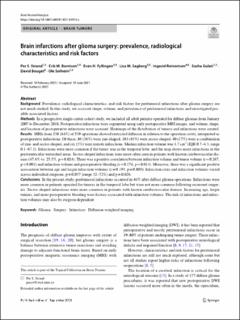| dc.description.abstract | Background: Prevalence, radiological characteristics, and risk factors for peritumoral infarctions after glioma surgery are not much studied. In this study, we assessed shape, volume, and prevalence of peritumoral infarctions and investigated possible associated factors. Methods: In a prospective single-center cohort study, we included all adult patients operated for diffuse gliomas from January 2007 to December 2018. Postoperative infarctions were segmented using early postoperative MRI images, and volume, shape, and location of postoperative infarctions were assessed. Heatmaps of the distribution of tumors and infarctions were created. Results: MRIs from 238 (44%) of 539 operations showed restricted diffusion in relation to the operation cavity, interpreted as postoperative infarctions. Of these, 86 (36%) were rim-shaped, 103 (43%) were sector-shaped, 40 (17%) were a combination of rim- and sector-shaped, and six (3%) were remote infarctions. Median infarction volume was 1.7 cm3 (IQR 0.7-4.3, range 0.1-67.1). Infarctions were more common if the tumor was in the temporal lobe, and the map shows more infarctions in the periventricular watershed areas. Sector-shaped infarctions were more often seen in patients with known cerebrovascular disease (47.6% vs. 25.5%, p = 0.024). There was a positive correlation between infarction volume and tumor volume (r = 0.267, p < 0.001) and infarction volume and perioperative bleeding (r = 0.176, p = 0.014). Moreover, there was a significant positive association between age and larger infarction volumes (r = 0.193, p = 0.003). Infarction rates and infarction volumes varied across individual surgeons, p = 0.037 (range 32-72%) and p = 0.026. Conclusions: In the present study, peritumoral infarctions occurred in 44% after diffuse glioma operations. Infarctions were more common in patients operated for tumors in the temporal lobe but were not more common following recurrent surgeries. Sector-shaped infarctions were more common in patients with known cerebrovascular disease. Increasing age, larger tumors, and more perioperative bleeding were factors associated with infarction volumes. The risk of infarctions and infarction volumes may also be surgeon-dependent. | en_US |

